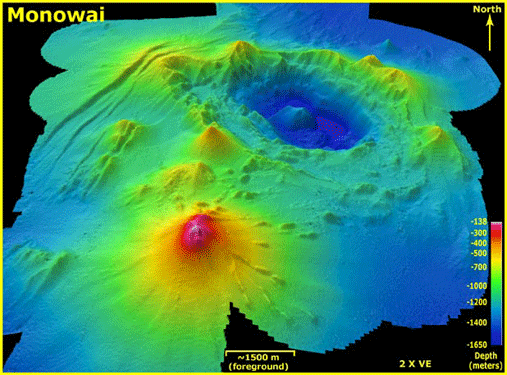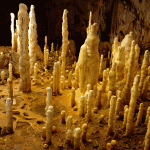
The Monowai volcanic centre is comprised of the Monowai cone (southwest) and the 10 kilometre Monowai Caldera in the northeast. Image: GNS and NOAA
A submarine volcano has undergone the fastest rate of growth and collapse ever recorded.
Monowai is located 1000 kilometres northeast of New Zealand’s North Island and is one of the most active submarine volcanoes in the Tonga-Kermadec arc, a 2500 kilometre-long chain of submarine volcanoes stretching from New Zealand to just north of Tonga. This volcanic cone underwent a geological upheaval over five days in mid-2011, providing scientists with new insight on the behaviour of submarine cones.
Monowai added 8.5 million cubic metres of lava and debris to its summit during the time it was under observation. This new material raised the summit height by 79 metres, while a collapse in a different part of the summit caused a height reduction of 19 metres.
This suggests that submarine volcanoes can grow and collapse at much faster rates than previously known, according to GNS Dr Cornel de Ronde, co-author of the study published in Nature Geoscience. “The rate of change we observed is a reminder of how rapidly geological processes such as submarine volcanism and landsliding can occur.” These growth rates also shed light on the emplacement of surface magma for submarine volcanoes.
The scientists suspected that Monowai was undergoing a growth spurt when they approached the volcano in 2011 and observed discoloured gas and bubbles rising to the surface. Several Pacific seismic stations also recorded shallow earthquakes in the area over five days.
When the scientists returned three weeks later, they found that part of the volcano had grown while another part had collapsed. Monowai added four new growth structures during the process.
“It’s remarkable that we were able to capture such dramatic geomorphic changes on the seafloor within the duration of a single research voyage,” de Ronde says. The fast growth rate may have implications for our understanding of geohazards such as tsunamis.
“Given our general paucity of information of volcanic events on the seafloor, we could find ourselves in a situation where previously we thought a volcano was benign, to one where it has suddenly become potentially dangerous to sea traffic and also neighbouring states if a tsunami was generated following collapse,” explains the researcher.






